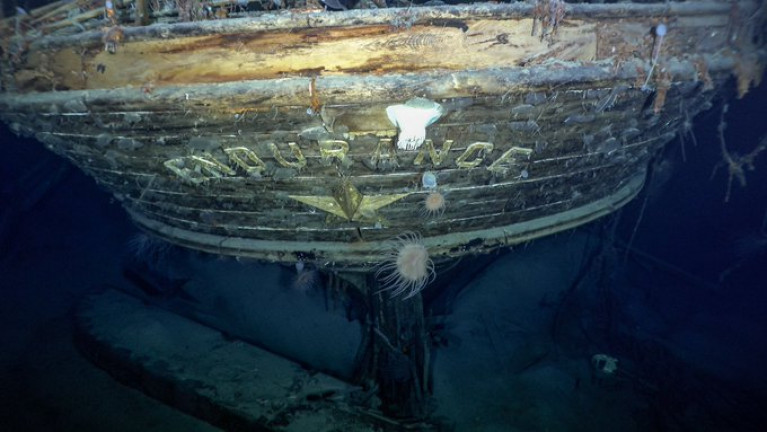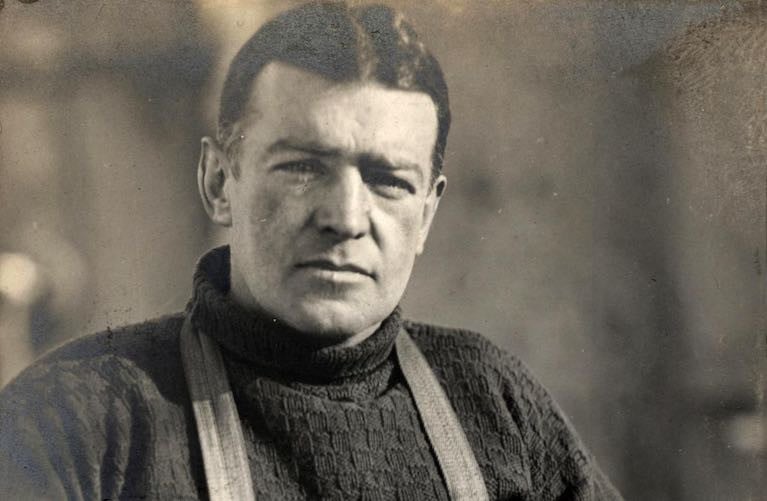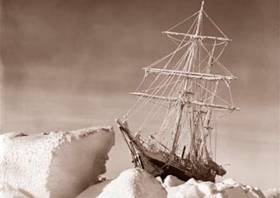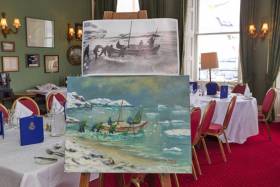Displaying items by tag: Shackleton
Mensun Bound Among Speakers at Shackleton School
Wildlife cameraman Doug Allen and British maritime archaeologist Mensun Bound, who was part of the team which discovered Shackleton’s Endurance, are among speakers at this year’s Shackleton School, which takes place in person this autumn.
Nicknamed the “Indiana Jones of the deep” by Discovery Channel, Bound was among the team on board the SA Agulhas II, which found the wreck of the Endurance in March 2022.
Among his many other expeditions, Bound directed the excavation of the Etruscan 6th-century BC shipwreck off Italy’s Giglio island. It is believed to be the oldest known shipwreck of the Archaic era.

Director of Norway’s Fram Museum Geir Klover will speak about Shackleton and Amundsen, while Kevin Kenny will open the school with an introduction to “The Boss”.
Astrid Furholt will speak about “Finding your South Pole”, and Katherine MacInnes will give a talk on Scott’s fatal Antarctic expedition through the eyes of the women they left behind.
Registration for the school, which runs from October 28th to 30th, is open now and details are downloadable below
A perimeter measuring 500m is being implemented to aid the protection of Endurance, the ship famously lost in the Antarctic by explorer Ernest Shackleton.
The vessel's position on the Weddell Sea floor was (as Afloat reported) finally identified in March, 107 years after its sinking.
Member states of the Antarctic Treaty have already declared the wreck, which lies in 3,000m of water, a Historic Site and Monument (HSM).
Now they have asked for a management plan to guide its ongoing conservation.
This will be drawn up by the UK Antarctic Heritage Trust (UKAHT). It will determine the kinds of restrictions and responsibilities that will be placed on anyone who goes near Endurance in the future.
Even now a permit is required to visit the ship says BBC News which has report with videos and images.
A new expedition to find the wreck of Sir Ernest Shackleton’s Endurance will set sail for Antarctica one month after the centenary of his death.
According to The Irish Times, the Endurance22 Expedition aims to find, survey and film the wreck of Endurance, which sank in the Weddell Sea during the Anglo-Irish explorer’s mission to Antarctica in 1915.
Sea ice trapped the three-masted barquentine for more than 10 months before the crew — including Kerryman Tom Crean — escaped by foot and in lifeboats.
The expedition sets out from Cape Town in South Africa on 5 February. Mission director Mensun Bound said: “We will do everything we can to survey and capture footage of Endurance and to bring the epic tale of her final voyage, and of the leadership, courage and fortitude of her crew, to people around the world.”
This past Tuesday 5 January in Connemara, a group of enthusiasts marked 100 years since Shackleton’s passing with readings, recitations and song, as previously reported on Afloat.ie.
Shackleton Centenary Marked by Midnight Gathering in Connemara
The night before Ernest Shackleton died a century ago today (Wed Jan 5) in Antarctica, he wrote in his diary of the “lone star” Sirius which was “hovering gem-like above the bay”.
A group of enthusiasts searched for the same star in the sky above Connemara last night (Tues Jan 4) as they marked 100 years since the explorer’s passing with readings, recitations and song.
The group is associated with the Shackleton museum and autumn school in Co Kildare, and they made their midnight rendezvous near Letterfrack, Co Galway. The event was not public, due to Covid-19 restrictions.
Letterfrack is where the ship’s cabin in which “The Boss” drew his final breath has been undergoing restoration, since it was donated by Norwegian owner Ulfe Bakke.
Bakke’s great grandfather retrieved the cabin from Shackleton’s last ship, Quest, which he acquired for an expedition to Antarctica to clear his debts.
Some of Shackleton’s last diary entries, passages drawn from books such as South, and poems often quoted by the explorer were read.
Verse was drawn from the work of Robert Browning, Rudyard Kipling, William Sharp and Gerard Gould, while music included a recording of “The Night Shackleton Died” by meteorologist and expedition banjo player Leonard Hussey.
As Kenny explained, Shackleton’s last days were “ poignantly and poetically” recorded in his diary entries, and these were also quoted last night.
“Rest and calm after the storm,” Shackleton wrote on January 1st, 1922.
“ The year has begun kindly for us. It is curious how a certain date becomes a milestone in one’s life,” he recorded.
“Anxiety has been probing deeply into me for until the end of the year things have gone awry,” he had noted.
“ Engines were liable: furnace cracked. Water short. Heavy gales. All that physically can go wrong but the spirit of all onboard sound and good.”
Shackleton wrote of passing their first iceberg on January 2nd, 1922, and “the old familiar sight aroused in me memories that the strenuous years have deadened”.
“Blue caverns shone with sky glow snatched from heaven itself. Green spurs showed beneath the water,” he wrote, adding
“and bergs mast high
came sailing by
as green as emerald”.
He confessed to be still anxious and unsettled on January 3rd, and “I am so much on the qui vive. I pray that the furnace will hold out”.
On January 4th, the ship Quest anchored at Grytviken, the whaling station in South Georgia where the “old smell of dead whale permeates everything”, and it is “a strange and curious place”.
“A wonderful evening,” he wrote.
“In the darkening twilight I saw
a lone star hover: gem like above the bay..”
A full programme of centenary events will be released by the Shackleton committee on February 15th, Shackleton’s birthday.
The Shackleton Museum in Co Kildare has welcomed a commitment by Minister for Foreign Affairs Simon Coveney to ensure Ireland signs up to the Antarctic Treaty.
The Athy museum said it was particularly fitting in the approach to the centenary of Ernest Shackleton’s death in January 2022.
Coveney was speaking in the Seanad on a Green Party motion seeking to secure Ireland’s accession, which secured all-party support on Wednesday night.
 Committed - Minister for Foreign Affairs Simon Coveney
Committed - Minister for Foreign Affairs Simon Coveney
Coveney said he was “very committed to getting this done", but said there were “serious issues” including legislative and policy requirements that needed assessing.
"We need to be credible if we're going to do this properly,” he said, setting a target date of the end of the first quarter of 2022 and promising to report back to the Seanad.
The Seanad motion to join the treaty, which 53 states have signed up to, was introduced by Green Party senator Vincent Martin.
The treaty, described as a positive example of multilateralism, commits to access to Antarctica for peaceful purposes only.
It promotes international scientific cooperation, and agreement to set aside disputes over territorial sovereignty.
The Green Party motion urged the Government to complete its assessment of the necessary commitments for accession to the Antarctic Treaty; to commit to taking all necessary steps to accede as soon as possible.
The motion also requested the Minister for Foreign Affairs to provide an update on progress made by his department in the assessment of the commitments necessary for accession to the treaty.
The Government agreed not to oppose the motion, and it received all-party support in the Seanad.
The Antarctic Treaty System (ATS) comprises the Antarctic Treaty (1959), the Convention on the Conservation of Antarctic Marine Living Resources, the Convention for the Conservation of Antarctic Seals 1972, and the Madrid Protocol on Environmental Protection 1991.
Ireland considered joining the Antarctic treaty system over ten years ago, but it was found that complex legislation would have to be enacted first, making it a “criminal offence for any citizen of Ireland to commit in Antarctica any act or omission which, if committed in Ireland, would be a criminal offence in the State”.
It was also found that “significant commitments” would have to be made by a number of government departments.
The Shackleton Museum chair and board said the Seanad motion was “particularly welcome as we approach the centenary of the death of Ireland’s leading polar explorer, Ernest Shackleton in January”.
“Shackleton is the key person in Ireland’s links to the Antarctic and it is particularly fitting as his expeditions all had important science and climate objectives,” it said.
Shackleton's "Crow's Nest" from his Last Ship Loaned to Irish Museum For His Centenary
When Irish adventurer Sir Ernest Shackleton was asked to give his expertise at the inquiry into the sinking of the Titanic, he singled out the need to slow down through the ice and the value of a ship’s lookout or “crow’s nest”.
Now the crow’s nest from his own last polar ship, Quest, has been given on loan to the Shackleton Museum in Athy, Co Kildare which is preparing to mark the centenary of his death next year.
The “crow’s nest” - a type of barrel in which a look-out stood at the top of a mast- was essential for ships travelling in the ice to spot leads or routes through ice fields.
The Quest’s “crow’s nest” was heated through an internal piping system, reflecting Shackleton’s belief that his crew would endure more hardship if they had the best working conditions possible.
The adventurer also believed that while a “crow’s nest” could fit two, only one person should ever be on duty.
 The crow's nest or lookout from The Quest, Shackleton's last ship
The crow's nest or lookout from The Quest, Shackleton's last ship
“One man gives more attention to the work in hand than two men,” Shackleton advised the Titanic inquiry.
The “crow’s nest” is one of only two surviving items from The Quest, which Shackleton died of a heart attack on while in Antarctic’s South Georgia on January 5th, 1922.
The ship’s cabin in which he lay has been undergoing restoration in Ireland, having been donated to the Kildare museum by Norwegian Ulfe Bakke whose family had maintained it since 1922.
The “crow’s nest” from the ship was given to the church of All Hallows by the Tower in London.
“The church authorities at All Hallows by the Tower have facilitated the loan to the Athy museum for the centenary year, given that Kildare was Shackleton’s birthplace,”Kevin Kenny of the Shackleton Autumn School explained.
The artefact will be on display for the next few months in Athy, and will then travel later in the year on loan to South Georgia.
The Athy museum has many other items relating to Shackleton, including an original sledge and harness from his Antarctic expeditions.
The New Zealand government facilitated the donation of the sledging harness to Kildare County Council in 1923, the year after Shackleton’s death.
The annual autumn school, Virtually Shackleton 2021, takes place this Saturday (Oct 30), and speakers will include Jan Chojecki, a grandson of John Quiller Rowett who sponsored Shackleton’s final expedition, the Shackleton Rowett expedition.
Virtually Shackleton 2021 is free of charge, but registration is required here
The Shackleton Endurance Antarctic Expedition Just Keeps On Giving
When Afloat.ie's Shipping Correspondent Jehan Ashmore scooped all other media last week with the revelation that the new Irish Research Vessel will be named Tom Crean, the wave of warmth and sheer goodwill which greeted the news was remarkable. For although you don't have to know all the details of the heroically-failed Imperial Trans-Antarctic Expedition of 1914-1917, you'll know that it was led by Ernest Shackleton of a Kildare family, and you'll further know that over the years, one of its true heroes has emerged as Tom Crean of Annascaul in County Kerry.
 Tom Crean of Annascaul, Co Kerry, in the Antarctic
Tom Crean of Annascaul, Co Kerry, in the Antarctic
Their ship Endurance became trapped and ultimately crushed in the ice, and in the end their only hope of salvation was for Shackleton to take a small but select crew including Tom Crean in the modified 22ft ship's lifeboat James Caird, and sail the 600 miles from Elephant Island in the Antarctic across the Great Southern Ocean to South Georgia, starting on 24th April 1916 when the stormy southern Autumn was already well advanced.
Their success in completing the voyage, and the subsequent securing of a ship in South America in order to successfully retrieve their 22 shipmates left behind on Elephant Island, deservedly became the stuff of legend. For at a time when the World War of 1914-1918 was at its height with deaths already in the millions, Shackleton had saved all his men through inspired leadership and management of such quality that his conduct of the expedition has become a regular study in advanced management institutes.
 Harry McNish at the vital task of converting the lifeboat James Caird into a sailable seagoing propositions on Elephant Island.
Harry McNish at the vital task of converting the lifeboat James Caird into a sailable seagoing propositions on Elephant Island.
 Job done. Without the luxury of sea trials of any kind, the Harry McNish-modified lifeboat James Caird was launched at Elephant Island on 24th April 1916, and immediately departed on the 600-mile passage across the Great Southern Ocean to South Georgia
Job done. Without the luxury of sea trials of any kind, the Harry McNish-modified lifeboat James Caird was launched at Elephant Island on 24th April 1916, and immediately departed on the 600-mile passage across the Great Southern Ocean to South Georgia
It remains a source of a fascination which continues to grow, not least in the tragedy of knowing that, having brought his men safely home against all odds, Shackleton had to live with the knowledge that several were soon killed on being drafted in for active service in the Great War.
But though his great success in completing the incredible voyage to South Georgia has been honoured - not least in the fact that it has attracted at least five re-enactments in replicas of the James Caird - there is one cause of concern which many share, and that's the way in which Shackleton allocated the very special Polar Medals which King George V had created to honour the expedition.
For Shackleton's list was to very deliberately exclude four members of the crew that "The Boss" – as he was invariably called – felt had not really pulled their weight, and one of those was Henry McNish, the Ship's Carpenter, who was actually fully trained as a shipwright, but was game for any job to do with working with wood.
However, McNish (or McNeish) was like a caricature of a Glaswegian, with a sometimes obtuse personality and a Scots accent often impenetrable to people of an English background like Shackleton, who'd gone to school at Dulwich College south of London, such that their relationship was an almost immediate area of friction and misunderstanding.
Yet there's no denying that Harry McNish was a very able carpenter, busy with jobs well done while the Endurance voyaged south, while his ultimate achievement was the conversion to a seagoing sailboat of the lifeboat James Caird, with raised topsides and a proper deck using any materials he had to hand, including planks which he had to create by sawing up a spare spar.
 The Supervisor Cat – a crewmate's impression of Harry McNish and his cat Mrs Chippy at work aboard Endurance
The Supervisor Cat – a crewmate's impression of Harry McNish and his cat Mrs Chippy at work aboard Endurance
And once the job was done, McNish was selected to be on the crew across to South Georgia, despite the fact that he and Shackleton seemed scarcely able to be in each other's presence. Shackleton later said that the main reason he brought McNish along on the Caird voyage was because he was a very vocal socialist who kept his own journal of the voyage, and was likely to foment trouble if left behind in Elephant Island.
Another source of friction lay in the fact that McNish had been the only crewmember who brought along a pet on the ship, his cat Mrs Chippy. Mrs Chippy happened to be a neutered male, but whatever the officers may have thought, Mrs Chippy was much liked by everyone in the crew, and it was a source of much pain when Shackleton decreed that he'd to be left behind on the Endurance, and shot dead as they left in order to save him from a long and lingering death through starvation and cold.
 The James Caird approaching South Georgia at the conclusion of her incredible voyage from Elephant Island
The James Caird approaching South Georgia at the conclusion of her incredible voyage from Elephant Island
With so much bad blood between them, Shackleton's non-award of the Polar Medal to Harry McNish now defines our perceptions of their relationship. Shackleton himself wasn't to be around long to be aware of this, as he died aged only 47 of heart failure in South Georgia while leading his third expedition to the Antarctic 1922.
But although McNish was to die destitute in New Zealand in 1930, there was already a feeling that he'd been badly done by on the Polar Medal, with his rejection a very public snub. And since then, there has been a growing ground swell in favour of the view that he deserved better of Shackleton.
One who thinks that very strongly is Arctic veteran Jarlath Cunnane of Mayo who – in the latest edition of the Irish Cruising Club Annual superbly edited by Maire Breathnach – tells of how he has been getting himself through the lockdowns by using his very handy building shed near Rosmoney on Clew Bay to build a replica of the James Caird in honour of Harry McNish.
 Jarlath Cunnane with the James Caird replica hull in frame at Rosmoney on Clew Bay. Photo: Mick Brogan
Jarlath Cunnane with the James Caird replica hull in frame at Rosmoney on Clew Bay. Photo: Mick Brogan
 Getting there. The planking advances on the new replica
Getting there. The planking advances on the new replica
The original James Caird is preserved on exhibition in Dulwich College (incidentally also the alma mater of P. G. Wodehouse and Raymond Chandler, a most unlikely grouping with Ernest Shackleton), and during a lifting of restrictions, Jarlath and fellow Mayo sailing polymath Mick Brogan got themselves to Dulwich to confirm measurements, as the James Caird's precise dimensions somehow became a matter of debate.
Now the hull of the Harry McNish is completed to the James Caird's original form, but Jarlath Cunnane is waiting until the spirit of the difficult but talented Glaswegian, who made her into a seagoing sailing proposition, comes along to visit Rosmoney and gives his approval for the final planks to go in.
 The shape of the original James Caird hull has now been replicated this week at Rosmoney, and they await the spirit of Harry McNish to tell them to add the planks as he did in 1916. Photo: Jarlath Cunnane
The shape of the original James Caird hull has now been replicated this week at Rosmoney, and they await the spirit of Harry McNish to tell them to add the planks as he did in 1916. Photo: Jarlath Cunnane
Meanwhile, in New Zealand, Harry McNish (they called him McNeish) has acquired an almost cult status. It began at his death in 1930, when the New Zealand authorities suddenly discovered who had been living quietly among them, and they gave him a state funeral with full Naval Honours to Karori Cemetery in Wellington. It all then became complete when a determined little statue of Mrs Chippy was placed on the grave in 2016.
And who knows, but perhaps none of this – whether at Rosmoney or in Wellington – might have happened, had not Shackleton denied Harry McNish his well-earned Polar Medal.
 Forever together. Mrs Chippy immortalized in stone on Harry McNish's grave in Wellington, New Zealand
Forever together. Mrs Chippy immortalized in stone on Harry McNish's grave in Wellington, New Zealand
What Would Irish Explorer Shackleton Do in a Crisis?
Pandemic restrictions have forced us all to live like trapped adventurers “on a metaphorical ice floe”, according to the Shackleton Museum in Athy, Co Kildare
And so “What would Shackleton do?” was the title of five podcasts which it released free to the public last year.
The short recordings drew on the Kildare-born adventurer’s key characteristics for successful exploration - optimism, patience, idealism and courage.
An extra one – “kindness” - was added by the museum podcast team, working with producer Dr Juliana Adelman, assistant professor of history at Dublin City University.
 Dr Juliana Adelman
Dr Juliana Adelman
The series was introduced by the explorer’s cousin, Jonathan Shackleton, and participants included actor John Carty of Sligo’s Blue Raincoat Theatre Company.
When the vessel Endurance hired for Shackleton’s Transantarctic expedition was finally crushed by pack ice in late 1915,” the Boss” painted a cheery vision.
“The ship and the stores are gone, so now we are going home", the explorer told his crew after they had retrieved food, drink, photographs and musical instruments and taken to floating ice.
Time and again, he reinforced this vision, Shackleton Museum director Kevin Kenny explains, and his optimism was perhaps best displayed by his decision to embark with five others on a seemingly desperate 800-mile sea journey to fetch help,
“Patience” – the theme of the second podcast – was the name Shackleton chose for the initial ice floe encampment, fellow museum director and historian Seamus Taaffe notes.
The explorer had no patience when at home, as he could be impetuous and moody, and had a terrible business sense, with a tobacco company, goldmining in central Europe and an attempt to ferry troops to Russia among his failed ventures.
However, Shackleton was “quite a different man on the ice”, and in extreme circumstances, Taaffe says.
His crew nicknamed him “cautious Jack”, and he was inspired by Rudyard Kipling’s poem, If, which he had hung in his ship’s cabin.
Reflecting back on the series, still available to be heard, Dr Adelman spoke to Wavelengths about how it started and why it is still so relevant now.
You can listen to Dr Adelman’s interview on Wavelengths below
The “What would Shackleton do?” podcast series is here
#Shackleton - A new expedition is being launched next year that will attempt to find the wreck of Ernest Shackleton’s Endurance in the Antarctic.
As BBC News reports, the primary focus of the scientific mission is to study the Larsen C Ice Shelf, from which one of the biggest icebergs ever recorded split last summer.
But since the ice shelf is close to the last known position of the Endurance, which was lost in 1915, “it would be a shame not to [try to find it],” said Prof Julian Dowdeswell, director of the Scott Polar Research Institute at Cambridge who is leading the international mission.
It’s expected that ROVs for surveying the ice shelf will also be used to have a deeper look beneath the thick ice in the Weddell Sea where the Endurance is believed to lie.
BBC News has much more on the story HERE.
#RStGYC - The Royal St George Yacht Club hosted a special presentation of a painting to mark the 100th anniversary of Shackleton's voyage on the James Caird from the South Shetlands to South Georgia.
Painted by Jim Sweeney from Frank Hurley's original photograph, 'Launching the James Caird from the shore of Elephant Island, 24 April 1916' recognises the centenary of the desperate 800-mile search for help across Antarctic waters by a crew that included in its number fellow Irish explorer Tom Crean.
The presentation followed a reception in March at the British Embassy to honour the crew of the Imperial Trans-Antarctic Expedition of 1914-1916 – also known as the Endurance expedition.

































































